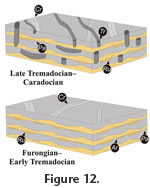| |
INFAUNALIZATION IN OFFSHORE ENVIRONMENTS:
THE IMPORTANCE OF THE TRICHOPHYCUS ICHNOFABRIC
 Comparison of the Furongian to lower Tremadocian and upper Tremadocian to Caradocian upper-offshore deposits (Figure 12) reveals differences between the two in both the taxonomic composition of the trace-fossil assemblages and especially, the nature of the ichnofabric. While Furongian-lower Tremadocian upper-offshore deposits are characterized by two-dimensional ichnofabrics in fairweather suites, the upper Tremadocian-Caradocian deposits display three-dimensional Trichophycus ichnofabrics, resulting in significant disruption of the primary sedimentary fabric. This ichnofabric reflects more extensive infaunal ecospace utilization by the late Tremadocian. Comparison of the Furongian to lower Tremadocian and upper Tremadocian to Caradocian upper-offshore deposits (Figure 12) reveals differences between the two in both the taxonomic composition of the trace-fossil assemblages and especially, the nature of the ichnofabric. While Furongian-lower Tremadocian upper-offshore deposits are characterized by two-dimensional ichnofabrics in fairweather suites, the upper Tremadocian-Caradocian deposits display three-dimensional Trichophycus ichnofabrics, resulting in significant disruption of the primary sedimentary fabric. This ichnofabric reflects more extensive infaunal ecospace utilization by the late Tremadocian.
Trichophycus is currently interpreted as a feeding trace (fodinichnion) or dwelling trace (domichnion) (Seilacher and Meischner 1965;
Osgood 1970;
Seilacher 1983,
2007;
Fillion and Pickerill 1990;
Jensen 1997). The retrusive sand-dominated spreite is most likely produced by sediment that passively infilled the structure, being packed against the floor by the producer (Osgood
1970). The striated ornamentation, the sharp outline, and the passive fill suggest an open burrow (Osgood 1970;
Fillion and Pickerill 1990;
Jensen 1997;
Droser et al. 2004). The well-developed striations imply excavation in a relatively firm substrate, consistent with a mid-tier emplacement below the sediment-water interface. The striated ornamentation of Trichophycus indicates the presence of some sort of scraping tool in the producer. Traditionally arthropods and annelids have been invoked as potential tracemakers (Seilacher and Meischner 1965;
Osgood 1970;
Jensen 1997).
Seilacher and Meischner (1965) suggested trilobites, although the type material of Trichophycus is unilobed, and scratch marks do not display a typical trilobite-like arrangement (see
Osgood 1970). Accordingly, a form referred to as Teichichnus duplex by
Schlirf and Bromley (2007), which is bilobed and ornamented with transverse to oblique scratch marks, is more reminiscent of Cruziana rather than Teichichnus or Trichophycus.
Jensen (1997) related the presence of radiating sets of striae to a symmetric radial digging apparatus akin to the spiny proboscis of priapulid worms. Although button-like terminations are not present in our material, their abasence is most likely considered a preservational bias.
It has been proposed that the depth and extent of the mixed layer has increased through the Paleozoic (Droser et al. 2004). As a result of a very shallow mixed layer during the early Paleozoic, firmground conditions occur near the sediment surface. This fact may have favoured preservation of shallow-tier trilobite trails and resting traces with well-developed scratch marks. An overall decrease in the abundance and diversity of Cruziana and Rusophycus occurs through the Paleozoic (Seilacher 1970,
1992;
Mángano and Droser 2004;
Droser et al. 2004); trilobite-produced trace fossils are most characteristic of Cambrian to Lower Ordovician strata (Mangano and Droser 2004). Notably, while Lower Ordovician offshore deposits contain abundant, diverse, trilobite-produced biogenic structures (e.g., Cruziana, Rusophycus, Dimorphichnus), these are rarely the dominant component in Upper Ordovician fully marine deposits (Mangano and Droser 2004). In contrast, Trichophycus ichnofabrics are well represented through the rest of the Ordovician. The addition of Thalassinoides isp. during the Arenigian resulted in increased reworking of fine-grained deposits.
Endobenthic organisms partition the energy sources available by inhabiting different tiers. In the absence of episodic sedimentation, tiered communities move upwards to maintain the same relative position as sedimentation gradually accretes (Bromley 1996). Pronounced, rapid changes in environmental conditions, as from storm processes, affect infaunal communities and thus their tiering profiles strongly. In the deposits studied, distal storm events have frequently interrupted fairweather bioturbation. In most cases, Trichophycus burrows penetrate into the thin sandstone tempestites, resulting in thorough bioturbation of storm deposits (Figure 10.7). However, relatively thick sandstone beds may have acted as a physical barrier to the producer, as specimens of Trichophycus can be observed penetrating into the mudstone and reaching the top of the underlying sandstone bed without crossing it.
In contrast to younger Paleozoic and post-Paleozoic marine deposits (e.g.,
Mángano et al. 2002;
Buatois et al. 2003b;
Carmona et al. 2008), deep infaunal ecospace is not colonized, and the tiering structure remains relatively simple. In fact, in the studied offshore deposits Trichophycus is commonly the only mid-tier component, in contrast to younger marine deposits that typically display a large variety of mid-tier trace fossils dominated by those produced by crustacean (Carmona et al. 2004,
2008).
|